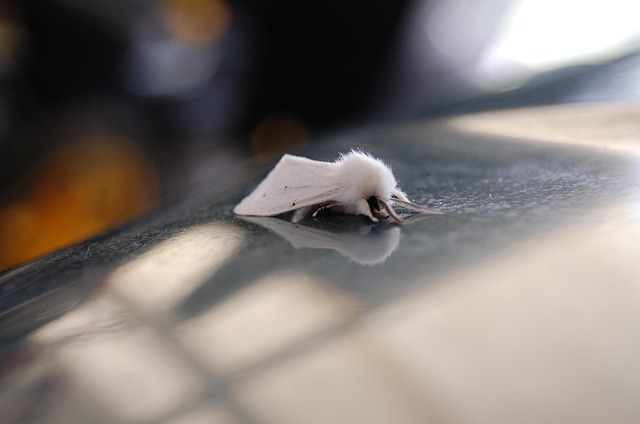Early detection of a clothes moth infestation is crucial. Look for signs like holes, webbing, and frass residue. Moths prefer dark, cluttered areas. Infestations can start from natural fibers or contaminated materials. Preventative measures include regular inspections and storing garments in breathable containers. Professional services use specialized equipment to eliminate eggs and hidden sites. Tailored strategies are needed due to moths' diverse nature; this includes good ventilation, cleaning, and natural deterrents for natural fibers. Regular monitoring and early intervention prevent recurrences of clothes moth infestation treatment.
Tired of discovering holes in your favorite fabrics? You’re not alone. Clothes moths are common pests that can wreak havoc on wardrobes and storage areas. This comprehensive guide delves into the world of clothes moth infestation treatment, equipping you with the knowledge to identify and combat these tiny invaders. From recognizing signs and sources to implementing targeted treatments and long-term solutions, we provide fabric-specific strategies for effective moth prevention and removal.
Identifying Clothes Moth Infestation: Signs and Sources
Identifying a clothes moth infestation is crucial for effective clothes moth infestation treatment. The first signs often include noticeable holes in fabrics, especially in areas hidden by seams or folds. You might also find webbing or silk-like frass (excrement) residue on your garments or in storage spaces. These moths prefer dark, undisturbed areas, so cluttered wardrobes and unused fabric stacks are prime targets.
Sources of infestation can vary. Natural fibers like wool, silk, and cotton are primary attractants, especially if they are stored for extended periods without regular rotation. Infestations can also originate from outside sources, such as contaminated dry cleaning materials or packages arriving from areas known to have moth problems. Regularly inspecting your fabrics and storing them in clean, breathable containers can help prevent these unwanted visitors.
Targeted Treatments for Wardrobes and Storage Areas
Many homeowners often overlook wardrobes and storage areas when it comes to pest control, but these spaces can be breeding grounds for unwanted visitors like clothes moths. Targeted treatments are essential to effectively address a clothes moth infestation treatment. Professional services employ specialized equipment and chemicals that go beyond surface-level cleaning, reaching the nooks and crannies where moths lay eggs and feed on fabrics.
These targeted treatments ensure that not only visible damage is repaired but also that future infestations are prevented. By understanding the habits and life cycles of clothes moths, experts can implement strategies to eliminate existing problems and create an environment that discourages their return.
Fabric-Specific Strategies for Moth Prevention and Removal
Moth prevention and removal from fabrics requires tailored strategies due to the diverse nature of materials. For natural fibers like wool, silk, and cotton, a multi-pronged approach is essential. First, maintain excellent ventilation in storage areas to disrupt moth reproduction cycles. Regularly launder or dry clean these fabrics to eliminate any egg or larvae presence. Using cedar closets or placing lavender sachets can also act as natural deterrents.
In the event of a clothes moth infestation treatment, identifying the specific type of moth is crucial. Casein moths, for instance, prefer proteins in older items, while webbing moths thrive on synthetic fabrics. Targeted treatments, such as applying safe insecticides designed for fabric or using pheromone traps, can effectively eradicate these pests. Regular monitoring and early intervention are key to preventing recurrences.
Long-Term Solutions: Maintaining a Moth-Free Environment
To prevent a recurring clothes moth infestation treatment, establishing a long-term solution involves creating an environment that discourages moths. Regular cleaning and vacuuming are essential to remove moth larvae and webbing, which often hide in corners and crevices. Focus on using natural deterrents like lavender, cedar, or rosemary oils, which have been proven effective in repelling moths naturally.
Sealing your wardrobe and storage areas with a tight-fitting cover can also help. This physically blocks access for moths, preventing them from laying eggs and feeding on fabrics. Additionally, maintaining low humidity levels is crucial, as moths thrive in moist environments. Using dehumidifiers or ensuring proper ventilation can create an inhospitable atmosphere, making it harder for moths to survive and breed.
In addressing the vexing issue of clothes moth infestations, a multi-faceted approach reaps the best results. By identifying signs early, targeting treatment for wardrobes and storage areas, employing fabric-specific strategies, and implementing long-term solutions, you can reclaim a moth-free environment. Remember that proactive prevention and regular maintenance are key to keeping these pests at bay. With the right knowledge and targeted treatments, eradicating clothes moths from your space is achievable.
